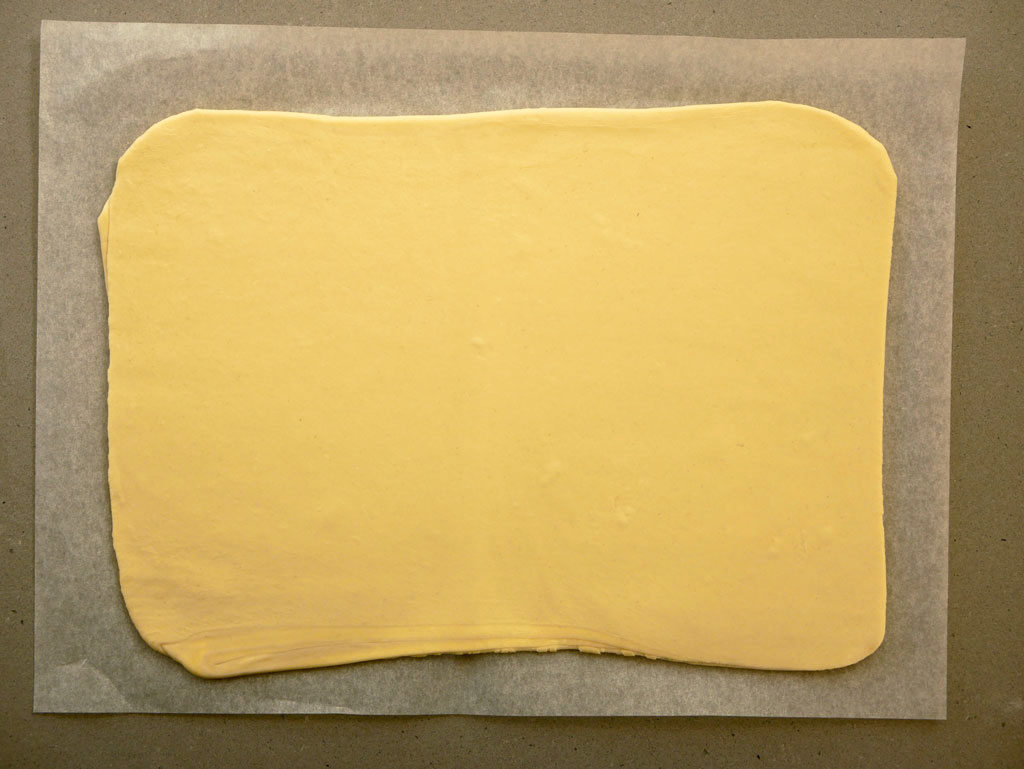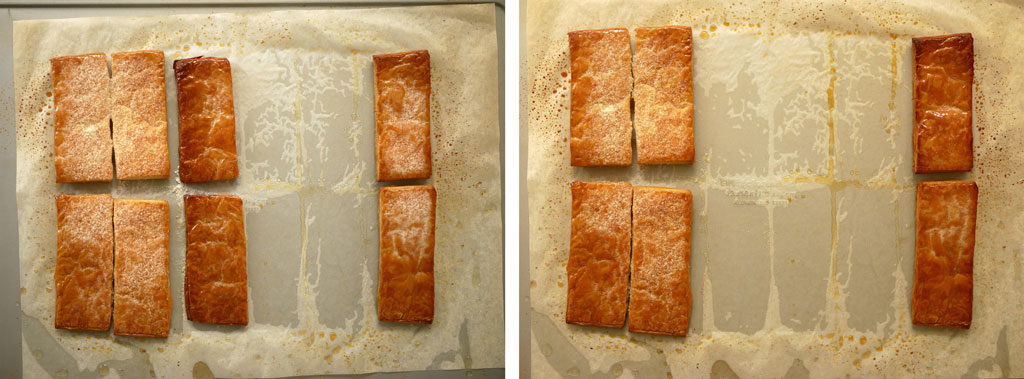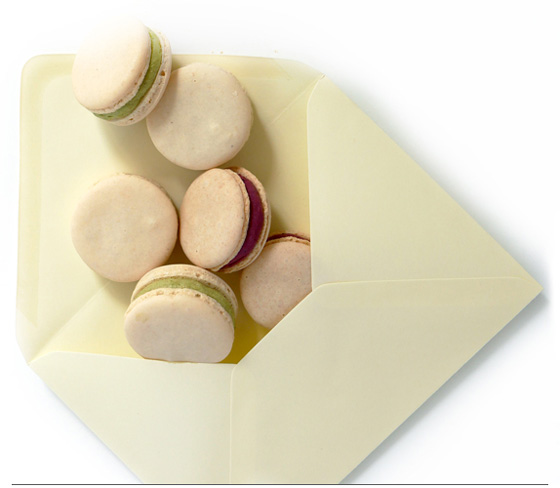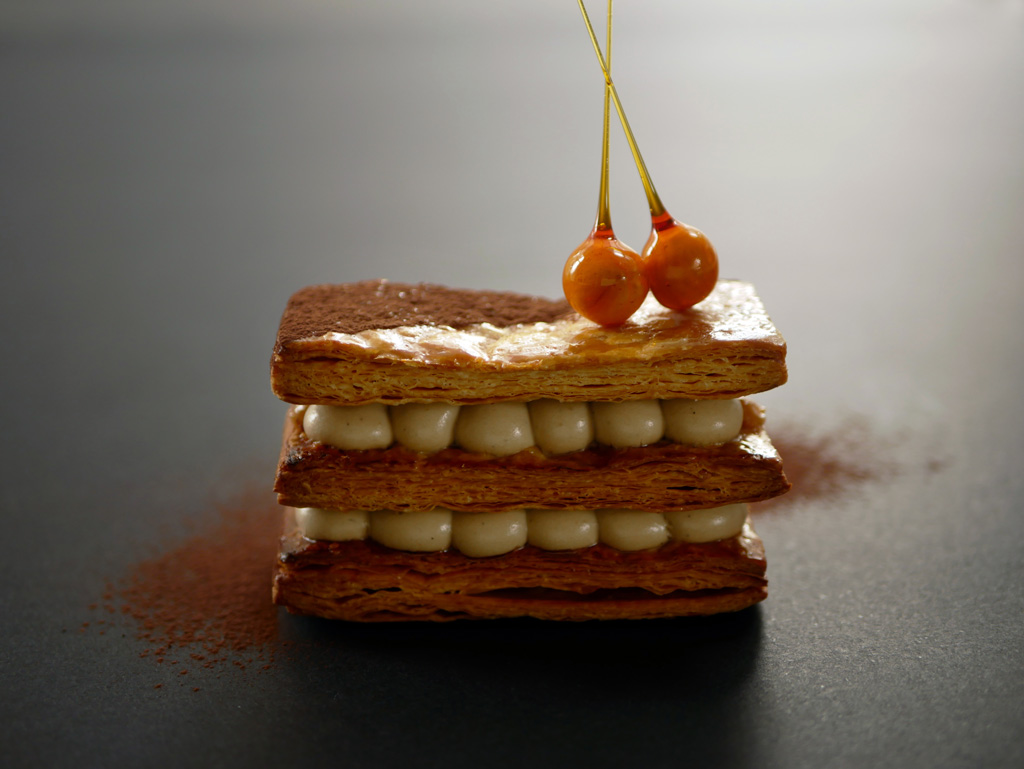Coffee and Hazelnut Mille-feuille


This mille-feuille is an incarnation of another dessert I tried to make with Oren a few months ago. We tried to make a Bûche de Noël with coffee diplomat cream and a hazelnut nougat ripple. It turned out so delicious, but couldn’t hold its shape. Maybe ‘cause we tried to make a joconde from hazelnuts, maybe ‘cause the cream was too supple or maybe, just maybe, we didn’t have luck on our side. I didn’t want to let go of the flavors and started looking for another dessert that would work with them, until I reached the perfect one – mille-feuille.
Mille-feuille is a classic French dessert found in almost any respectable Parisian patisserie display. Of course, you can just buy puff pastry, bake it, make the delicious creams and assemble everything. Or, alternatively, you can make homemade puff pastry and be even more proud of the final outcome. Indeed, there’s much to do and the work is great, but so is the feeling of satisfaction at the end of it all. In any case, I explain in the recipe how to bake with either homemade puff pastry or its store-bought equivalent.
Making puff pastry is a long and complicated process. It took me a long time to understand how to bake the dough properly in a home oven that usually doesn’t bake evenly. You can see from the images below how the dough is baked on the edges a lot more that at its center.
…
To make sure it baked more evenly, instead of baking it whole and then cutting it into rectangles, I cut the dough into rectangles and only then baked it. It gave me flexibility during baking. Every time a rectangle was ready I would just take it out of the oven and keep baking the rest.
To be honest, I’m not exactly sure how you’re supposed to eat a mille-feuille. If you try to cut it or take a bite from all its layers at once, the cream splatters in every direction. So I just removed the top rectangle, tossed it aside, separated the two bottom layers and ate each one separately. The flaky consistency of the dough works beautifully with this wonderful cream.
Unfortunately, this is also a weak point for the mille-feuille. Once the dessert is ready, the dough starts to absorb the humidity from the cream and loses its flakiness. One of the most common practices among pastry chefs is to make the cream and puff pastry separately and assemble only when it’s time to serve the dessert. So I warmly advise to postpone the assembly until you’re ready to serve it. Otherwise, assemble the mille-feuille and keep it in the fridge for up to two days max.












Ingredients
Puff pastry layers
1 kg homemade puff pastry (or store-bought)
Hazelnut praliné
35 g water
100 g sugar
100 g peeled and roasted hazelnuts
Pinch of salt
Nougat cream
100 g hazelnut praliné
40 g heavy cream
Coffee diplomat cream
125 g espresso (2 Nespresso capsules)
125 g milk
60 g egg yolk
60 g sugar
10 g flour
15 g corn starch
½ tsp vanilla paste
25 g butter (cut into cubes)
50 g heavy cream
Decoration
Cocoa powder
Caramelized hazelnuts
Equipment
Pastry bags fitted with a smooth 8 mm piping tip
2 baking trays to be used as weight (about 2 kg total)
The recipe makes 8 laminated mille-feuille desserts
Puff pastry layers
Homemade puff pastry
Make the puff pastry following this post. When the dough is ready, divide it in two. Keep one half of the dough in the fridge. In a cool room, roll out the other half on a lightly floured surface to a thickness of 4-5 cm. While rolling, flip the dough occasionally and make sure it doesn’t stick to the surface.
(!) I advise to let the dough rest in the fridge for about 10 minutes during the rolling process so it would be easier to reach the desired thickness.
Keep the rolled out dough in the fridge. Roll out the other half of the dough in a similar way and keep it in the fridge as well, for about 15-20 minutes.
Using a ruler and a sharp knife, mark and then cut 11×5 cm rectangles. Cut the dough by pulling the knife through the dough and not in one strike to get a nice laminated profile of the layers after baking. Keep in the fridge for about 10 more minutes. Preheat the oven to 190 °C (375 °F).
Remove the dough from the fridge and place it on a different baking tray. Cover the dough with parchment paper. Place two baking trays on top of the dough (The weight I used: 2 kg total). Place it in the middle of the oven. Bake for 35 minutes.
…
When it’s time to remove the dough from the oven, first increase the temperature to 220 °C (430 °F) and only then remove the whole pile from the oven. Remove the two trays on top. Using a sieve, spread a thin layer of powdered sugar on the dough rectangles.
Put the uncovered dough back in the oven and place it on the top shelf this time. Bake for about 10 more minutes. You have to stay close to the oven at this point (especially if the oven heat isn’t uniform). Every 2-3 minutes remove a dough rectangle from the oven when it looks ready.
How do you know if it’s ready? The dough must be baked throughout (golden/ light brown) and the sugar on top must be caramelized almost completely (clear and shiny). If however the sugar hasn’t fully caramelized but the dough starts to brown, just remove it from the oven so it won’t burn.
Repeat the same process with the other half of the dough. Chill at room temperature at the end.
Store-bought puff pastry
Spread the rolled out dough on a surface. Cut it into to two and place each part on a baking tray lined with parchment paper. Using a ruler and a sharp knife, mark and then cut cut 11×5 cm rectangles. Cut the dough by pulling the knife through the dough and not in one strike to get a nice laminated profile of the layers after baking. Keep in the fridge for about 10 more minutes. Preheat the oven to 180 °C (355 °F).
Remove the dough from the fridge and place it on a different baking tray. Cover the dough with parchment paper. Place two baking trays on top of the dough (The weight I used: 2 kg total). Place it in the middle of the oven. Bake for 30 minutes (or for 25 minutes if the dough is thin).
…
When it’s time to remove the dough from the oven, first raise the oven temperature to 200 °C (390 °F) and only then remove the whole pile from the oven. Remove the two trays on top. Using a sieve, spread a thin layer of powdered sugar on the dough rectangles.
Put the dough back in the oven and place it on the top shelf this time. Bake for about 10-20 more minutes (or 5-10 minutes if the dough is thin). You have to stay close to the oven at this point (especially if the oven heat isn’t uniform). Every 2-3 minutes remove a dough rectangle from the oven when it looks ready.
How do you know if it’s ready? The dough must be baked throughout (golden/ light brown) and the sugar on top must be caramelized almost completely (clear and shiny). If however the sugar hasn’t fully caramelized but the dough starts to brown, just remove it from the oven so it won’t burn.
Repeat the same process with the other half of the dough. Chill at room temperature at the end.
Hazelnut praliné
Peel the hazelnuts following the steps in this post. Lately I just prefer to do it using the quick method: roasting and rubbing. Roast a large amount of hazelnuts in an oven preheated to 180 °C (360 °F) for about 15-20 minutes. Remove from the oven and carefully transfer them onto a towel. Cover and rub them thoroughly until most of them are naked. Let the peeled hazelnuts cool at room temperature and then weigh the amount needed.
Caramel: Put water and then sugar in a saucepan. Place on medium heat. Stir the sugar with a spatula to dissolve it. Once the water starts to boil, stop stirring and remove the spatula. Keep on medium heat until you get an ember – light brown color. (You may slightly tilt the saucepan now and then to get a more uniform heating).
Important (!) The more you cook the caramel, the darker the color will be. The caramel might become bitter.
Once you reach the desired color, remove the saucepan from heat. Add hazelnuts and salt to the saucepan. Mix until all hazelnuts are covered in a thin layer of caramel. Pour the caramelized hazelnuts and all the remaining caramel onto a baking paper (no need to separate them just yet). Let them cool down at room temperature.
Break the chunk of hazelnuts into smaller pieces and transfer to a small food processor. Grind in short pulses until you obtain a powder and then grind again at high speed until you get a creamy hazelnut paste. Scrape the sides occasionally. The process could take up to 10 minutes. Weigh the amount needed and put it in a bowl.
Nougat cream
Bring the heavy cream to a boil. Pour immediately into the praliné bowl. Mix well until uniform. Keep in the fridge for at least an hour or until the cream is ready to be piped.
Coffee diplomat cream
Make two espressos (from 2 coffee capsules) and pour them into a saucepan. Add milk and vanilla to the saucepan. Start warming on medium heat. Add about a third of the sugar to the milk. Add the rest of the sugar to the egg yolks and whisk immediately. Add flour and corn starch and whisk again.
Once the mixture starts to boil, remove from heat and pour into the yolk-sugar mix while whisking all along. Pour the mixture through a sieve back to the saucepan (to get rid of egg chunks that may have hardened while adding the hot milk). Heat on medium heat and whisk constantly until the mixture thickens and becomes creamy. Remove from heat when the cream begins to bubble. (Be careful not to overcook, once the cream thickens it’s almost ready).
Transfer the creamy mixture to a clean bowl. Add the butter cubes and mix until uniform. Lay plastic wrap on top of the cream to keep a crust from forming while. Let it cool in the fridge for about an hour.
Putting the mille-feuille all together!
Arrange the dough rectangles in trios according to size. If some of the rectangles don’t fit in size, you may saw them with a serrated knife to make them fit.
Fit a pastry bag with a smooth 8 cm tip and fill it with the nougat cream. Pipe a strip of the cream along the center of two rectangles in each trio.
Go back to the coffee cream. Whip the cold heavy cream to soft peaks (beware not to over whip, the goal is to get a texture that resembles that of a thick yogurt). Transfer a fourth of the whipped cream to the coffee cream and mix well with a spatula. Fold the rest of the whipped cream to the coffee cream. Fit a pastry bag with a smooth 8 cm tip and fill it with the cream.
Pipe little mounds of coffee cream in two rows on top of two rectangles in each trio. Pipe the mounds really close to the nougat cream and even a little on top of it.
Keep it all in the fridge for about 10-15 minutes to let the cream set a little. Remove from the fridge. Place the two dough rectangles on top of each other. Place the third empty dough rectangle on top of them.
Using a sieve, spread cocoa powder (or powdered sugar) on top of each mille-feuille. Decorate with caramelized hazelnuts. Serve immediately or keep the mille-feuille desserts in the fridge in an airtight container up to two days.

Related Posts
4 Comments
Leave a reply:Cancel reply

Search the blog
![]()
Get updates by email














My diplomat cream is too runny. Any advice on how to fix it ?
Sorry to hear that.
It might be undercooked. You should leave it on the stove and keep mixing until it becomes creamy. Other than that, I can’t really think why it won’t set for you. Maybe the ingredients in your country act differently than in mine? I’m not sure.
bravo Hussein . follow your dream meriem
That’s so sweet of you! Thank you meriem 🙂